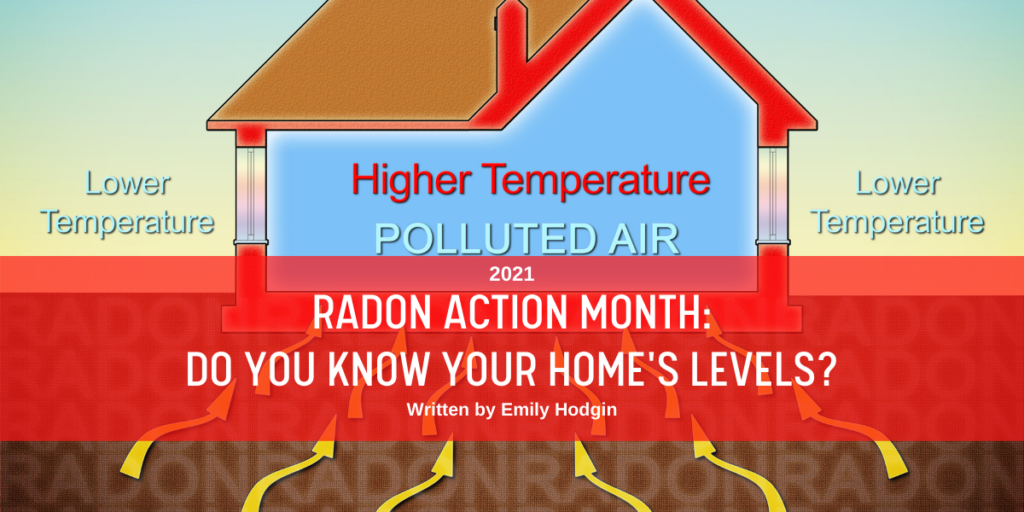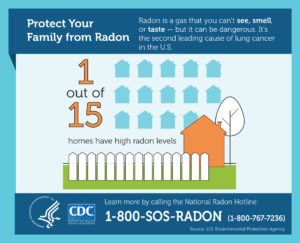Radon Action Month: Do You Know Your Home’s Levels?

By: Emily Hodgin, Insightful Healing
In 2012, my neighbor was in the process of selling her home. She sent me a text that their radon level came back at 24, which is six times the recommended level. She therefore suggested we test our radon levels. Having no idea what radon was, I consulted the internet. A quick Google search later, I learned that radon is the second leading cause of lung cancer in the United States, behind cigarette smoke. It is an odorless radioactive gas, occurring naturally in our atmosphere, and is prevalent in Iowa.
Looking through our home purchase paperwork, I found where we clearly waived the radon test. Our prior home had sold very quickly, and we didn’t want anything to slow down the closing date on our new home. I shared the information with my husband, and we both thought it was important to learn more, but we didn’t take action. A few days later, we learned I was pregnant with our second child. Radon went to the back of our minds.
Inspired by Gail Orcutt

Six months later, I attended a Beyond Pink TEAM (BPT) Young Cancer Survivor meeting where Gail Orcutt was our featured speaker and the topic turned out to be radon. Gail was an engaging presenter, a genuine, warm soul with an infectious laugh. Her advocacy on radon exposure was monumental.
According to the Iowa Department of Public Health:
“The Iowa Radon Survey has indicated that Iowa has the largest percentage (or 71.6%) of homes above the US Environmental Protec
tion Agency action level of 4pCi/L (picocurries per liter). It is also designated by the US EPA as an entirely zone 1 state, which means that at least 50% of the homes are above US EPA’s recommended action level.”
This is due to the glacial deposits in our area of the United States. It gets more scientific from there, so I won’t try to paraphrase, but the research is readily available for your consumption. As a result of hearing Gail’s personal lung cancer experience and her research, I inquired about purchasing test kits. Luckily, Gabbi DeWitt, Health Educator for the Black Hawk County Health Department, coordinates our BPT meetings and had kits available for $10.
My husband first set up the kit, followed the instructions and then sent it off. The results came back at over 15 pCi/L (picocurries per liter). We were concerned. The EPA recommends homes be mitigated if the radon level is 4 pCi/L or more. But the reality is, there is no known safe level of exposure to radon. Gail advocated for the reduction of that threshold to 1 pCi/L.
Radon Mitigation
 I asked around and learned many people had built homes with the option to set up a radon mitigation system, but some chose not to install one. With the newest member of our family arriving soon, we didn’t have money budgeted for a mitigation system. But at the end of the day, how could we knowingly ignore the risk? I’d already experienced cancer in my early 20s, and my children are at a higher risk of developing it. The physical, emotional and monetary cost of cancer treatment far outweighs the cost of a radon mitigation system. We knew it was the necessary next step.
I asked around and learned many people had built homes with the option to set up a radon mitigation system, but some chose not to install one. With the newest member of our family arriving soon, we didn’t have money budgeted for a mitigation system. But at the end of the day, how could we knowingly ignore the risk? I’d already experienced cancer in my early 20s, and my children are at a higher risk of developing it. The physical, emotional and monetary cost of cancer treatment far outweighs the cost of a radon mitigation system. We knew it was the necessary next step.
We quickly contacted a mitigation company, who provided outstanding customer service and installed our system. After follow-up testing, our radon levels were reduced to 0.02 pCi/L. We continue to test every two years and the results remain very low. I have observed more awareness in the last 8 years regarding radon, but we need additional education and advocacy. Radon mitigation is a simple solution that could save lives. I credit Gail Orcutt for the increased radon awareness in Iowa, and my hope is that her message continues to be shared by each of us.
Radon Resources:
